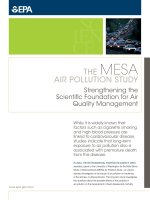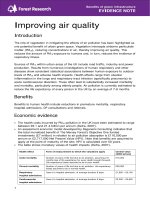Air quality thad godish 4th edition
Bạn đang xem bản rút gọn của tài liệu. Xem và tải ngay bản đầy đủ của tài liệu tại đây (7.36 MB, 519 trang )
www.elsolucionario.org
www.elsolucionario.org
www.elsolucionario.org
Air Quality
4th Edition
Thad Godish
LEWIS PUBLISHERS
A CRC Press Company
Boca Raton London New York Washington, D.C.
www.elsolucionario.org
Cover image provided by the SeaWiFS Project, NASA/Goddard Space Flight Center and
ORBIMAGE.
Library of Congress Cataloging-in-Publication Data
Godish, Thad. Air quality/Thad Godish.—4th ed. p. cm. Includes bibliographical references and
index. ISBN 1-56670-586-X 1. Air-Pollution. 2. Air quality management. I. Title. TD883.G57
2003 363.739′2—dc21 2003047412
This book contains information obtained from authentic and highly regarded sources. Reprinted
material is quoted with permission, and sources are indicated. A wide variety of references are
listed. Reasonable efforts have been made to publish reliable data and information, but the author
and the publisher cannot assume responsibility for the validity of all materials or for the
consequences of their use.
Neither this book nor any part may be reproduced or transmitted in any form or by any means,
electronic or mechanical, including photocopying, microfilming, and recording, or by any
information storage or retrieval system, without prior permission in writing from the publisher.
The consent of CRC Press LLC does not extend to copying for general distribution, for promotion,
for creating new works, or for resale. Specific permission must be obtained in writing from CRC
Press LLC for such copying.
Direct all inquiries to CRC Press LLC, 2000 N.W. Corporate Blvd., Boca Raton, Florida 33431.
Trademark Notice: Product or corporate names may be trademarks or registered trademarks, and
are used only for identification and explanation, without intent to infringe.
Visit the CRC Press Web site at www.crcpress.com
© 2004 by CRC Press LLC
Lewis Publishers is an imprint of CRC Press LLC
This edition published in the Taylor & Francis e-Library, 2005.
To purchase your own copy of this or any of Taylor & Francis or Routledge’s collection of
thousands of eBooks please go to />No claim to original U.S. Government works
ISBN 0-203-49265-X Master e-book ISBN
International Standard Book Number 1-56670-586-X (Print Edition)
Library of Congress Card Number 2003047412
www.elsolucionario.org
Dedication
To the memory of Ed Lewis, publisher and friend.
This book is your continuing legacy.
www.elsolucionario.org
www.elsolucionario.org
Preface
This fourth edition of Air Quality has been written (as have previous editions) to provide
readers (students, instructors, consultants, government personnel, and others) with a
comprehensive overview of air quality, the science that continues to provide a better
understanding of atmospheric chemistry and effects on public health and the environment
and the regulatory and technological management practices employed in achieving air
quality goals.
It has been nearly two decades since I began to pen the words that comprised the first
edition. Much has changed. The Internet, that enormous library of information that was
so much a part of the writing of this edition, was virtually unknown outside the military
and academe (and even there it was still a foundling). The word processor had not quite
replaced the typewriter (when “cutting and pasting” was literally that). How long ago
technologically the early to mid-1980s now seem.
In the U.S. we are now well into our fourth decade of significant regulatory efforts to
“protect and enhance” the quality of the nation’s air. We accepted the challenge of
expanding our concerns to protect the Earth’s atmosphere from the effects of ozonedestroying chemicals that have threatened to destroy the ozone layer. We are, at present,
timidly moving toward accepting the challenges that the planet faces from greenhouse
gas-associated increases in global surface temperatures and the environmental changes
predicted to occur and already occurring.
In the 1970s and 1980s, acidic deposition was identified as a major environmental
concern in North America, and we responded by enacting and then implementing major
acidic deposition control measures. In conducting research studies on acidic deposition, it
became increasingly apparent that it was only a part of a much larger environmental
concern, atmospheric deposition, which includes mercury, nitrate nitrogen, and
organochlorine compounds such as pesticides, polychlorinated biphenyls (PCBs),
dioxins, and furans.
The health protection issues that dominate air quality management in the U.S.
continue to evolve as more powerful statistical procedures increasingly demonstrate that
pollutant exposures at levels previously considered safe cause adverse health effects, with
a resultant need for more stringent regulatory requirements. This has been particularly the
case for ozone and PM2.5 (particulate matter with an aerodynamic diameter of ≤2.5 µm).
Though we Americans and other citizens of the planet want clean air, regulatory
efforts impose real costs on the regulated community. Not surprisingly, American
industry is reluctant to bear the costs of new regulatory initiatives and is increasingly
challenging the historically better and better science that is driving the need for more
stringent environmental regulation.
This edition represents a significant revision of the previous one, including updated
content and changes to the way in which subject matter is presented. Chapters 2, 4, 5, 6,
and 10 reflect the first category, and Chapters 3, 6, 7, 9, 11, and 12 the second. This
edition also includes an extensive glossary.
www.elsolucionario.org
Air Quality continues to be a very readable text for advanced-level undergraduate and
beginning-level graduate students in environmental science; environmental management
technical programs at the junior college level; and programs serving public health,
industrial hygiene, and engineering needs. It is useful as a supplement to engineering
curricula where the primary focus is the design and operation of pollution control
equipment. It is also written for a variety of nonuniversity and noncollege readers who
have a professional or personal interest in the field.
Thad Godish
Muncie, Indiana
www.elsolucionario.org
Acknowledgments
I am indebted to my late colleague, Clyde Hibbs, professor of natural resources at Ball
State University, who encouraged me to write an air pollution book to serve the needs of
our environmental science majors. I am also indebted to the late Ed Lewis, who visited
my office one day in 1984 and invited me to be an author in his fledgling Lewis
Publishers, Inc. Flattered, I nevertheless felt overwhelmed by my increasingly expanding
research, consulting, and public service activities in the then-emerging field of indoor air
quality. Ed’s entreaties continued, and the first edition of Air Quality was the outcome.
Thus began a professional and personal relationship that significantly shaped my career.
In this writing effort I was provided the invaluable assistance of my spouse, Diana,
whose editorial skills considerably improved the readability and ultimate quality of this
edition.
As always, I am indebted to the many colleagues in colleges and universities in the
U.S. and other parts of the world who have elected to use Air Quality in their courses.
You have allowed me to expand my classroom to a much wider domain.
www.elsolucionario.org
www.elsolucionario.org
Contents
Chapter 1 The Atmosphere
1
Chapter 2 Atmospheric Pollution and Pollutants
26
Chapter 3 Atmospheric Dispersion, Transport, and Deposition
77
Chapter 4 Atmospheric Effects
101
Chapter 5 Health Effects
152
Chapter 6 Welfare Effects
196
Chapter 7 Air Quality and Emissions Assessment
232
Chapter 8 Regulation and Public Policy
275
Chapter 9 Control of Motor Vehicle Emissions
318
Chapter 10 Control of Emissions from Stationary Sources
341
Chapter 11 Indoor Air Quality
372
Chapter 12 Environmental Noise
419
Glossary
444
Index
467
www.elsolucionario.org
www.elsolucionario.org
CHAPTER 1
The Atmosphere
1.1 CHEMICAL COMPOSITION
1.1.1 General Composition
The Earth’s atmosphere is a mixture of gases and particulate-phase substances. The most
abundant of these, nitrogen (N2) and oxygen (O2), comprise approximately 78 and 21%,
respectively, of atmospheric mass and volume. A number of trace gases make up the
remaining 1%. Average concentrations (with the exception of stratospheric ozone, (O3)
are reported in Table 1.1. These include gases present in essentially constant
concentrations: N2, O2, argon (Ar), neon (Ne), helium (He), krypton (Kr), hydrogen (H2),
and xenon (Xe). Others vary temporally and spatially. These include water vapor (H2O),
carbon dioxide (CO2), carbon monoxide (CO), methane (CH4), O3, the nitrogen oxides
(nitrous oxide (N2O), nitric oxide (NO), and nitrogen dioxide (NO2)), ammonia (NH3),
formaldehyde (HCHO), sulfur dioxide (SO2), a number of reduced sulfur compounds
(dimethyl sulfide ((CH3)2S), carbon disulfide (CS2), carbonyl sulfide (COS), and
hydrogen sulfide (H2S)), and odd hydrogen species (hydroxyl radical (OH·),
hydroperoxyl radical (HO2·), and hydrogen peroxide (H2O2)). In addition to these gasphase substances, the atmosphere contains trace quantities of particulate nitrate (NO3−),
ammonium (NH4+), and sulfate (SO4–2).
Though N2 is the most abundant constituent of the atmosphere, it has a relatively
limited direct role in atmospheric and life processes. It serves as a precursor molecule for
the formation of NO3−, from which plant processes synthesize amino acids, proteins,
chlorophyll, and nucleic acids (organic molecules that are directly or indirectly essential
to all living things). The conversion of N2 to NO3− occurs as a result of atmospheric and
symbiotic biological processes.
Nitrogen reacts with O2 to produce nitrogen oxides (NOx) that include N2O, NO, NO2,
gas-phase nitric acid (HNO3), and short-lived substances such as dinitrogen pentoxide
(N2O5) and nitrate radical (NO3·). Concentrations of these compounds or substances,
unlike their precursors (N2 and O2), vary significantly in time and space. Nitrous oxide, a
relatively inert gas, was, until several decades ago, thought to be
Table 1.1 Atmospheric Gases
Chemical Species
Symbol
Concentration (%, ppmv, ppbv, pptv)
Nitrogen
N2
78.084%
Oxygen
O2
20.948
Argon
Ar
0.934
www.elsolucionario.org
Air quality
2
Water vapor
H2O
0.1–30,000 ppmv
Carbon dioxide
CO2
~370
Neon
Ne
18.18
Ozone (stratosphere)
O3
0.5–10
Helium
He
5.24
Methane
CH4
~1.72
Krypton
Kr
1.14
Hydrogen
H2
0.50
Xenon
Xe
0.09
Nitrous oxide
N2O
~0.33
Carbon monoxide
CO
110 ppbv (50–200)
Ozone
O3
20
Ammonia
NH3
4
Formaldehyde
HCOH
0.1–1
Sulfur dioxide
SO2
~1
Nitrogen dioxide
NO2
~1
Carbonyl sulfide
COS
500 pptv
Carbon disulfide
CS2
1–300
Dimethyl sulfide
(CH3)2S
10–100
Hydrogen sulfide
H2S
~50
Nitric oxide
NO
~50
Hydroxyl radical
OH·
0.1–10
Hydroperoxyl radical
HO2·
0.1–10
present in the atmosphere at constant levels. It is one of a number of substances whose
concentrations are increasing as a result of human activities.
The evolution of free atmospheric O2 at elevated concentrations set the stage for the
evolution of oxidative metabolism, the series of energy-transferring chemical reactions
that sustain most life forms. Oxygen, as a consequence, is vital to almost all living things.
It is a precursor for the production of O3 and development of the O3 layer, the
stratospheric region that absorbs high-energy ultraviolet (UV) light radiation streaming
into the Earth’s atmosphere from the sun. By absorbing most of the UV radiation incident
on the Earth and its atmosphere, the O3 layer shields most organic materials and living
things from UV’s destructive energy.
On average, background O3 levels in the troposphere are approximately 20 parts per
billion by volume (ppbv). Ozone concentrations vary, and there is evidence that average
levels are increasing as a result of human activities. At heights of 10 to 50 km (6.2 to 31
www.elsolucionario.org
The atmosphere
3
mi), O3 concentrations increase dramatically, with peak mixing ratio (parts per million by
volume (ppmv)) concentrations (defined in Chapter 7) observed at 35 km (21.7 mi)
(Figure 1.1); concentrations based on partial pressure or molecular density peak at 25 km
(15.5 mi). At about 15 km (9.3 mi), O3 concentrations are ~0.1 to 0.5 ppmv; at 20 km
(12.4 mi), 3 ppmv; at 35 km, 8 to 10 ppmv; and at 50 km, 2 ppmv.
In addition to these altitude-based differences, stratospheric O3 concentrations vary
from day to day, from one season to another, and latitudinally. There are also
Figure 1.1 Atmospheric O3
concentrations expressed as mixing
ratios (ppmv) and partial pressure
(nbars) as a function of height. (From
National Research Council, Rethinking
the Ozone Problem in Urban and
Regional Air Pollution, National
Academy Press, Washington, D.C.,
1991. With permission.)
www.elsolucionario.org
Air quality
4
significant variations that result from quasi-biennial oscillations (air movement in the
stratosphere), the 11-year sunspot cycle, and volcanic eruptions.
Ozone concentrations are also measured and reported as total column O3 (vertical sum,
reported as Dobson units). Mean monthly column O3 concentrations are illustrated as a
function of latitude and time of year in Figure 1.2. Column O3 concentrations are highest
at latitudes where O3 production is relatively low. Highest O3 values are found at high
latitudes in winter and early spring; the lowest values are found in the tropics. Most O3
production occurs near the equator where high levels of solar radiation are received; the
observed stratospheric O3 distribution reflects a strong poleward transport during winter.
In contrast to N2 and O2, the atmospheric concentration of CO2 is relatively low, about
0.037%, or 370 ppmv. Carbon dioxide is enormously important. It is one of the two
principal raw materials from which green plants (in the process of photosynthesis) make
food molecules on which most living things depend. Life is carbon based, and CO2 is the
source of that carbon. Carbon dioxide is also a major greenhouse gas and, because of its
thermal absorptivity, is responsible in good measure for maintaining a favorable global
heat balance.
Figure 1.2 Total column O3 (Dobson
units) averaged over the period 1979–
1986 reflecting latitudinal and seasonal
differences. (From WMO, Report of
the International Ozone Trends Panel:
1988, World Meteorological
Organization, Geneva, 1990.)
Water vapor is the atmospheric constituent with the highest degree of variability (0.1 to
30,000 ppmv). Like CO2, it is a major greenhouse gas, absorbing thermal energy radiated
from the Earth’s surface. Water vapor is significant in the atmosphere because it readily
changes phase. On cooling, it condenses to form tiny droplets of liquid H2O.
www.elsolucionario.org
The atmosphere
5
Helium, Ar, Ne, Kr, and Xe are noble gases. They are inert and, as a consequence, do
not appear to have any major effect on, or role in, the atmosphere.
Many of the variable trace gases are produced either bio- or geogenically. Most
important among these are NH3, CH4, H2S, CO, and SO2. Ammonia, CH4, and H2S are
produced primarily by biological decomposition. Methane is a thermal absorber and
serves as a greenhouse gas.
Other gas-phase species may be found in the atmosphere (in addition to those listed in
Table 1.1). These include organic substances released by plants, microorganisms, and, to
a lesser extent, animals. During the growing season, plants emit large quantities of
volatile substances such as isoprenes and pinenes. These biogenic substances are rapidly
removed by sink processes. Therefore, they are not described as being “normal”
constituents of the atmosphere.
1.1.2 Water
Water in its liquid phase covers approximately 70% of the Earth’s surface; in its solid
phase it forms the polar ice caps, glaciers, episodic snow and ice of our seasons, and ice
crystals of cold and very cold clouds. In its vapor phase it is a significant component of
the atmosphere, varying from trace levels up to ~3%.
Water is a unique constituent of the atmosphere in that it occurs under ambient
conditions as a solid, liquid, and gas. In some circumstances, all three phases are present
at the same time. Phase changes are significant in atmospheric processes that produce
“weather.”
In its vapor phase, H2O represents a variable component of the mixture of gases that
comprise the atmosphere. The combined pressure of these gases (Dalton’s law) describes
atmospheric pressure. The partial pressure of H2O vapor in an atmosphere is described as
vapor pressure. Vapor pressure increases and decreases with increasing or decreasing
concentrations of H2O vapor. Water vapor concentrations may be reported as absolute or
relative humidity. Absolute humidity may be expressed as density (mass/volume) or
vapor pressure (millimeters of mercury).
Relative humidity is expressed in percent; it is the percent H2O vapor a volume of air
holds at a given temperature. Since air can hold more H2O vapor at higher temperatures,
relative humidity values decrease as temperature increases. As air is cooled, relative
humidity increases until it reaches 100%, or the saturation value (saturation vapor
pressure). If cooled below the saturation value, condensation occurs. This is described as
the dew point, and the temperature at which the dew point occurs is called the dew point
temperature.
Relationships between temperature and relative humidity, relative humidity and dew
point temperature, and relative and absolute humidity can be seen in the psychrometric
chart in Figure 1.3.
As warm, moist air rises, it cools below the dew point. Subsequent condensation
produces clouds with droplet sizes one millionth the size of a rain droplet. Clouds are
masses of air with enormous numbers of condensed H2O droplets or ice particles that
initially are too small to appreciably fall through the atmosphere. As these droplets grow
by a millionfold, precipitation occurs. Clouds have very important
www.elsolucionario.org
Air quality
6
Figure 1.3 Psychrometric chart.
physical effects. They reflect sunlight back to space and are major contributors to the
Earth’s albedo, i.e., its ability to reflect sunlight. They also absorb heat, retarding its flow
back to space.
1.2 PHYSICAL PHENOMENA
The atmosphere is characterized by its constituent gas- and particulate-phase substances
and the physical forces and phenomena that act upon and within it. These include solar
radiation, thermal energy, gravity, air density and associated pressure, and the movement
of individual air molecules and the atmosphere itself.
1.2.1 Solar Radiation
The sun radiating energy approximately as a blackbody (perfect absorber and emitter of
radiation at all wavelengths) at an effective temperature of 6000 K “showers” the
atmosphere and the Earth’s surfaces with an enormous quantity of electromagnetic
energy. The total amount of energy emitted by the sun and received at the extremity of
the Earth’s atmosphere is constant, 1370 W/m2/sec. That received per unit area of the
Earth’s surface is 343 W/m2/sec.
Spectral characteristics of solar radiation, both external to the Earth’s atmosphere and
at the ground, can be seen in Figure 1.4. Over 99% of the energy flux from the sun is in
the spectral region of 0.15 to 4 µm, with approximately 50% in the visible light region of
0.4 to 0.7 µm. The solar spectrum peaks at 0.49 µm, the green portion of visible light.
Because of the dominance of visible light in the solar spectrum, it is not surprising that
www.elsolucionario.org
The atmosphere
7
life processes such as photosynthesis and photoperiodism (responses to changing day
length) are dependent on specific visible wavelength bands.
Incoming solar radiation is absorbed by atmospheric gases such as O2, O3, CO2, and
H2O vapor. UV light at wavelengths of <0.18 µm (180 nm) are strongly absorbed by O2
at altitudes above 100 km (62 mi). Ozone below 60 km (37.2 mi) absorbs most UV
between 0.2 and 0.3 µm (200 to 300 nm). Atmospheric absorption above 40 km (24.8 mi)
results in attenuation of ~5% of incoming solar radiation. Under clear-sky conditions,
another 10 to 15% is absorbed by the lower atmosphere or is scattered back to space, with
80 to 85% reaching the ground.
The Earth, however, has variable but significant cloud cover so that under average
conditions of cloudiness, a significant portion of the sun’s energy incident on the
atmosphere does not reach the Earth’s surface. Cloud droplets and other atmospheric
aerosols, as well as the Earth’s surfaces, scatter sunlight back to space. This backscatter
as seen from the moon makes the Earth a relatively bright planet. This phenomenon
describes the Earth’s albedo. The albedo varies considerably, with an average value
estimated to be ~30 to 35%; 30% is the most widely referenced value. Approximately
55% of the Earth’s albedo is due to clouds, 23% to cloud-free atmosphere, and about
22% to the Earth’s surface.
As can be seen in Figure 1.4, a significant portion of solar radiation incident on the
atmosphere is not received at the ground. In addition to reflection by clouds and
Figure 1.4 Solar spectra. (From
Krondratjev, K.Y., Radiation in the
Atmosphere, Academic Press,
NewYork, 1969. With permission.)
atmospheric aerosols, considerable attenuation of solar energy results from absorption of
different portions of the solar spectrum by atmospheric constituents such as H2O vapor,
CO2, O3, and O2. Carbon dioxide and H2O vapor primarily absorb in the infrared region,
www.elsolucionario.org
Air quality
8
O3 in the UV and portions of the visible region, and O2 in portions of the visible and
infrared regions.
1.2.2 Terrestrial Thermal Radiation
Since the Earth’s temperature is less than that of the sun, it absorbs and reradiates energy
at longer wavelengths than it receives. The Earth and its atmosphere radiate energy nearly
as a blackbody, with an effective temperature of 290 K. This results in an emission
spectrum primarily in the infrared region of 1 to 30 µm, with a peak at ~11 µm. A
nighttime thermal emission spectrum is illustrated in Figure 1.5 (note the significant
absorption due to CO2 and H2O vapor). The atmosphere is particularly transparent to
wavelengths in the infrared spectral region of 7 to 13 µm (described as the atmospheric
window). Nearly 80% of thermal energy emitted by the Earth’s atmospheric window
escapes to space. It is notable that most non-CO2/H20 vapor greenhouse gases (i.e., O3,
CH4, N2O, and chlorofluorocarbons (CFCs)) have strong absorption bands in this spectral
region. Water vapor is the most significant of all greenhouse gases, absorbing five times
the amount of thermal radiation as all other greenhouse gases combined.
1.2.3 Energy Balance
The Earth’s overall energy balance is illustrated in Figure 1.6. Incoming solar radiation
produces an energy input of 343 W/m2/sec. Of this, about 103 W/m2/sec is reflected back
to space. The fraction absorbed by the Earth-atmosphere system is about 240 W/m2/sec.
This corresponds to the net outgoing radiation flux of 240
Figure 1.5 Nighttime Earth
atmospheric emission spectrum. (From
Gates, D.M., Energy Exchange in the
Atmosphere, Harper and Row
Monographs, New York, 1962. With
permission.)
W/m2/sec (Figure 1.6). The radiative flux emitted at the Earth’s surface is 390 W/m2/sec,
which substantially exceeds the outgoing flux of 240 W/m2/sec. The difference reflects
the significant effect that clouds, H20 vapor, and greenhouse gases have in absorbing and
www.elsolucionario.org
The atmosphere
9
emitting thermal energy. Absorption of thermal energy by the atmosphere provides the
Earth with a relatively moderate average global surface temperature of ~15°C (59°F).
Figure 1.6 Earth’s energy balance.
(From Seinfeld, J.H. and Pandis, S.N.,
Atmospheric Chemistry and Physics:
Air Pollution to Climate Change, John
Wiley & Sons, New York, 1998. With
permission.)
1.2.4 Surface Temperatures
The quantity of solar radiation received at any location on the Earth’s surface is a direct
function of the sun’s angle of inclination. As a consequence, considerably more energy is
received and absorbed in equatorial than polar regions. In the tropics, average
temperatures exceed 22°C (71.6°F). Average temperature differences between the tropics
and poles are approximately 35°C (95°F).
www.elsolucionario.org
Air quality
10
As a result of these differences, thermal energy is transported poleward by air and
ocean currents. Warm currents move toward the poles; cold currents move toward the
equator. Considerable energy transfer also occurs by evaporation and condensation.
The unequal distribution of solar energy on the Earth’s surface and heat transfer
mechanisms result in observed differences in regional climate. Changes in the Earth’s
orientation to the sun that occur over the course of the year result in the temporal and
climatic temperature differences associated with the seasons, most notably in middle and
high latitudes.
1.2.5 Vertical Temperature Gradients
The atmosphere is characterized by significant temperature gradients in the vertical
dimension. These temperature gradients define the various layers or zones of the
atmosphere (Figure 1.7).
The troposphere, the lowest layer of the atmosphere, extends upward to the
tropopause, which begins at altitudes of 8 to 18 km (4.96 to 11.2 mi) depending on the
latitude and time of year. The troposphere is at its maximum height over the equator and
its lowest height over the poles. Temperature decreases steadily from an average of
~15°C (59°F) to −60°C (−76°F) at 15 km (9.3 mi). On average, temperature decreases at
a rate of −6.5°C/km. This progressive temperature decline is due to the increasing
distance from the sun-warmed Earth.
Because of the intense movement of thermal energy associated with heating of the
Earth’s surface and subsequent transfer to the atmosphere, the troposphere is relatively
unstable. This instability results in changes in day-to-day temperature, cloud cover, and
precipitation, a phenomenon we call weather. The troposphere is where we humans live
and all biological activity occurs.
The troposphere can be divided into two regions, i.e., the planetary boundary layer
(PBL), which extends upward to 1 km (0.62 mi) or more, and the free troposphere, which
extends up to the tropopause.
The tropopause, like other pauses, is an atmospheric zone where temperatures are
isothermal; i.e., no temperature change occurs with height. It is a relatively stable region
forming a boundary between the troposphere, where temperature decreases with height,
and the stratosphere, where temperature increases with height. The height of the
tropopause is often represented as extending from a few kilometers to ~10 km (~1 to 6
mi) (Figure 1.7).
Above the tropopause, temperature increases to an altitude of 45 to 55 km (27.9 to
34.1 mi) (where temperature is ~ −2°C (28.4°F). As such, stratospheric temperatures are
inverted relative to the troposphere. Consequently, the stratosphere is
www.elsolucionario.org
The atmosphere
11
Figure 1.7 Vertical temperature profile
and associated atmospheric zones.
relatively stable, with little vertical convective mixing. The increase of temperature with
height in the stratosphere results from the absorption of UV by O3. The highest
temperatures occur at the top of the stratosphere because of high-efficiency UV
absorption.
Few clouds (though stratospheric cloudiness is increasing) are present in the
stratosphere, and air movement is primarily horizontal. There is little manifestation of
weather-type processes.
The stratosphere and the atmospheric layers above it make up the upper atmosphere,
the troposphere being the lower atmosphere. Above the stratopause, temperature
decreases with altitude to −90°C (−130°F) at 85 km (52.7 mi), the coldest location in the
atmosphere. This region, the mesosphere, is characterized by rapid vertical mixing.
www.elsolucionario.org
Air quality
12
The thermosphere begins above the mesopause altitudes of 90 km (55.8 mi) and
extends outward to the atmosphere’s extremity (-1000 km, 620 mi). The high
temperatures that characterize it are produced as a result of absorption of shortwavelength radiation by molecules of N2 and O2. Temperatures reach ~1200°C (2128°F)
at 500 km (310 mi). These are, however, thermodynamic temperatures, which are a
measure of the energy of molecules. Because relatively few molecules are present,
standard thermometer temperatures are lower since fewer air molecules collide with the
thermometer.
Molecules of N2 and O2 are photoionized in the thermosphere region of 90 to 400 km
(55.8 to 248 mi). These molecules and atoms lose one or more electrons and thus become
positively charged ions. Electrons are set free and travel as electrical currents. The
principal chemical species found in the thermosphere are N2, O2, N, O, and the ions N2+,
O2+, N+, and O+.
This ionized layer of the thermosphere is described as the ionosphere. It is responsible
for formation of the aurora borealis (northern lights) and aurora australis (southern
lights). Auroras are closely related in time with solar flare activity and occur at the
Earth’s magnetic poles. As masses of protons and electrons approach the Earth from the
sun, they are captured by its magnetic field, which moves them toward the poles. As
these ions move, O2 and N2 are energized, emitting light characteristic of auroral
displays.
The electrical nature of the ionosphere varies as a result of changes in ion density.
Since ion production requires direct solar radiation, the concentration of charged particles
decreases at night. The ionosphere reflects AM radio signals back to Earth during
nighttime hours.
1.2.6 Gravity
Atmospheric gases are held close to the Earth’s surface by gravity. According to
Newton’s law of universal gravitation, all bodies in the universe attract each other with a
force equal to
(1.1)
where m1 and m2 are the masses of two bodies, G is the universal gravity constant
(6.67×10–11 Nm2/kg2), and r is the distance between the two bodies. It can be seen from
Equation 1.1 that the force (F) of gravity decreases as an inverse square of the distance
between two bodies.
In addition to holding air molecules close to the Earth’s surface, gravity plays a
significant role in atmospheric processes. As air cools, it becomes more dense and sinks.
On warming, it becomes less dense and rises. These mass/density changes result in
vertical air motions and contribute to planetary air circulation. Gravity also affects the
atmospheric residence time of atmospheric aerosols.
www.elsolucionario.org









